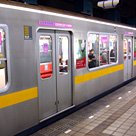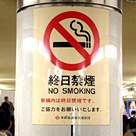Customs, Manners, and Etiquette
With their roots as an agricultural people, it is commonly said that the Japanese place importance on maintaining harmony within the group or organization to which they belong and do not act independently of others. However, in line with changes in contemporary society, a more Westernized, individualistic way of thinking, particularly among young people, is permeating attitudes and behavior. Nonetheless, as is evidenced by behavior at festivals, a belief in the importance of acting together as a group and maintaining a sense of solidarity remains deeply rooted in the Japanese psyche.
Particularly in urban areas, because the distance between workplace and home is quite far (many business persons must commute for over an hour between their offices and homes) and also since many children go to juku(cram schools) in order to prepare for entrance examinations (instead of going to public junior high schools, which do not require testing for entrance, after finishing their sixth year of elementary school, many children go to cram schools after their regular school to try to pass the private junior high school entrance exams), the time that families can share together at home every day has become very limited. In urban areas many places are open where food is served until late at night, and children can still be seen even at those hours in the town.
Several special customs and points about daily etiquette that would be useful for the foreign visitor to know are introduced below.
Seasonal customs
Hatsumode(first shrine or temple visit of the new year)
At the beginning of the year, people go to a shrine and, after tossing coins into an offering box called a saisembako, pray for happiness in the coming year. Shrine-goers can purchase amulets or charms for good health, success in an examination, safe driving, etc. or draw one's fortune written on a slip of paper (omikuji) for the coming year.

Shichi-go-san(five-seven-three)
This is a celebration for young girls who are three or seven years of age and for boys who are five years of age. Shichi-go-santakes place on November 14, and many parents dress their children in formal Japanese dress and take them to a shrine on that day.
Daily Life
Greetings
- Before eating a meal, Japanese say Itadakimasu("Thank you for letting me receive this.") and Gochisosama("Thank you for the delicious meal.") after finishing the meal. In the family in response to Gochisosama, the person who prepared the meal will respond by saying O-somatsu-sama("It was really not worthy of such praise.").
- Japanese bow to business associates or superiors when meeting and leaving them.
- Shaking hands is not a traditional custom in Japan, but these days if one extends one’s hand, a Japanese partner will feel no hesitation about shaking hands. However, there is no custom now to hug or embrace or make facial contact with close friends or romantic partners in public.
Visiting
- When visiting or going to a private home, a Japanese-style hotel, or a restaurant with a Japanese-style room (zashiki) with straw tatamimats on the floor, one should always take off one’s shoes before entering.
- When visiting a private home, visitors usually take a small gift for the host or family.
Eating
- Rice bowls and soup bowls should be held in the hand when eating or drinking from them. - Making a sound when sucking up soba, udon, or ramen noodles is considered the proper way to eat noodles. - When rice, accompanying dishes, and soup are served together, all the items should be eaten a little at a time so that everything is finished uniformly.
Restaurants
- Dining out has become quite common in urban areas, and restaurants in popular entertainment districts are open until relatively late at night. Some family restaurants and fast food chain restaurants are also open 24 hours a day. - Except for cafes and fast food restaurants where customers order at the counter and carry their purchases to their own seats, and small, inexpensive Japanese-style restaurants, customers should wait at their tables to be served.
Transportation
Except for in the Kansai area, people should keep to the left side on escalators if they are not going to walk up or down them (keep to the right in the Kansai area).
When getting on trains or busses, users should allow those getting off to go first. In trains and busses, there are seats designated as “Priority Seats” for elderly or disabled persons.
Depending on the commuter train, there are cars during certain time periods for female passengers only. (For example, cars on the Saikyo Line, which runs in the Tokyo metropolitan area.)
Cellular phones should be set on the silent call “manner mode” and calls should be avoided as much as possible when riding trains. Phones should be turned off when sitting near Priority Seats. On long-distance trains (Shinkansen, etc.), passengers should go out to the deck area when using cellular phones.
Taxis have automatic doors that are opened and closed by the driver. For single passengers, the passenger should sit in the back seat and not next to the driver.


Priority Seat mark
Smoking
With the exception of long-distance trains (and some subways), smoking is completely prohibited on all JR trains. Smoking is also prohibited on JR platforms except for designated spaces. Long-distance trains have both smoking and non-smoking cars; when purchasing reserved seat tickets, passengers are asked for their preference.
Smoking is prohibited on all domestic flights.
In taxis, the driver should be asked if it is permissible to smoke.
In some areas it is prohibited to smoke while walking on sidewalks, and violators can be fined.

No-Smoking mark
Japanese-style Inns (ryokan)| Soba| Udon| Ramen| Family Restaurants| Fast Food


